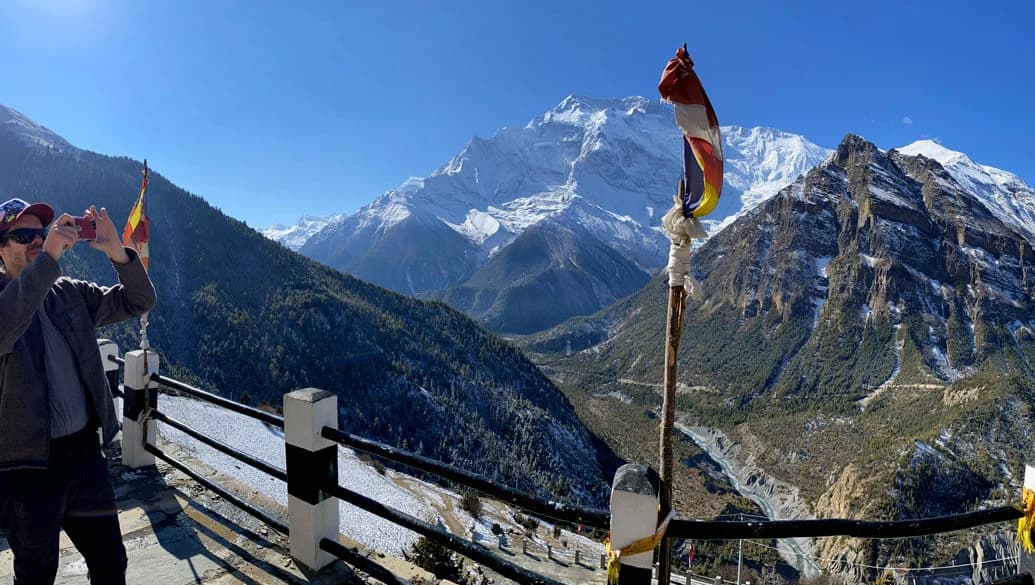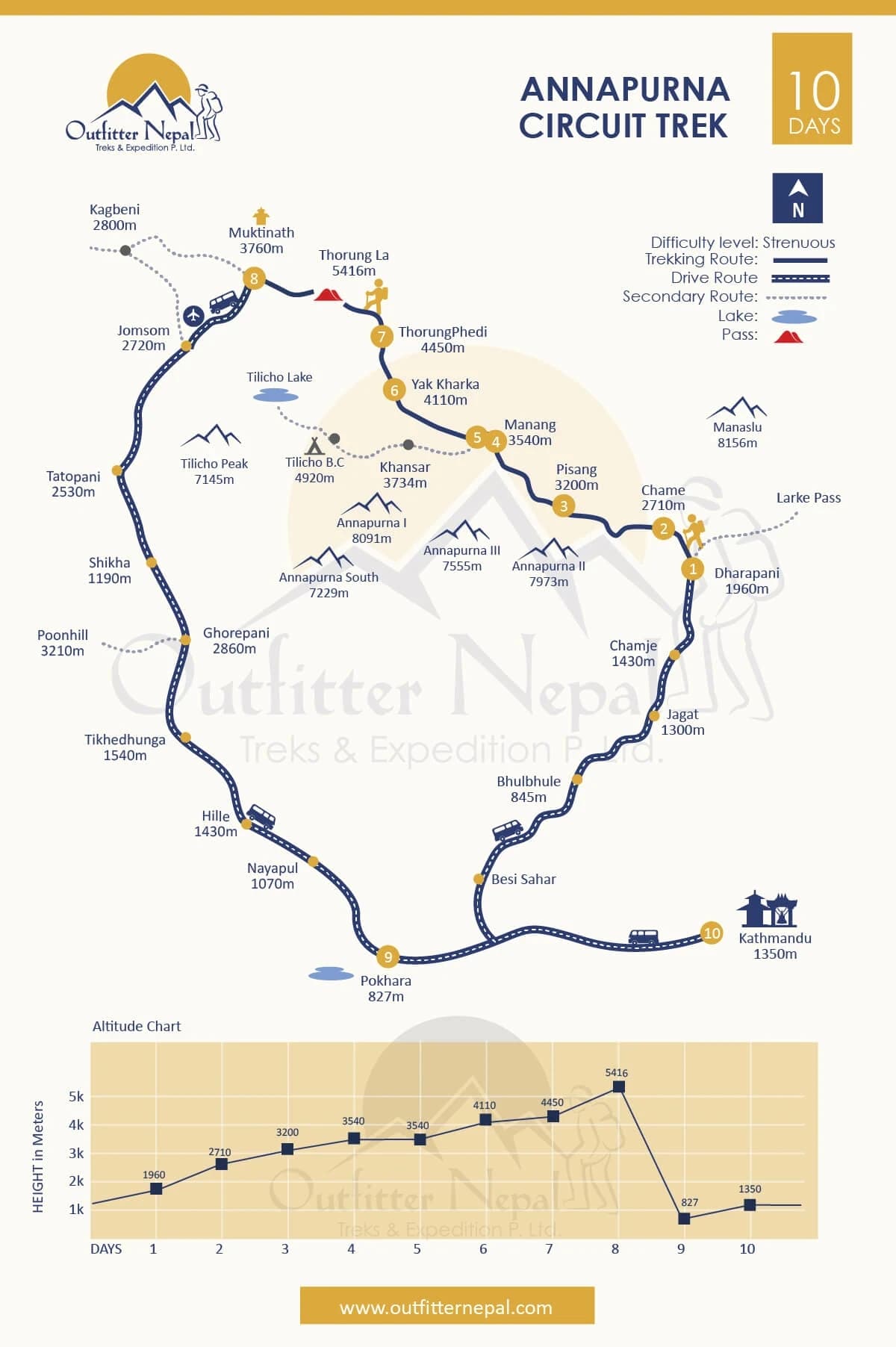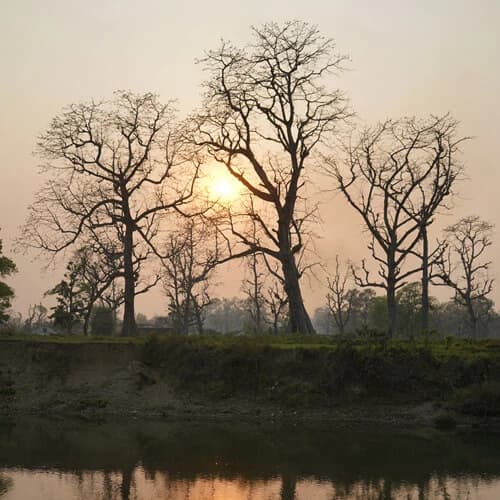Annapurna Circuit Trek 10 Days Highlights
- Conquer the Thorong La Pass (5,416 meters/17,769 ft), which is the trek's highest and most challenging point.
- A scenic hike with rewarding panoramic views of Annapurna and Dhaulagiri mountain ranges.
- Travel across diverse landscapes ranging from lush subtropical forests and terraced fields to high-altitude desert-like landscapes.
- Witness the majestic peaks of Annapurna II, III, IV, Tilicho Peak, Gangapurna, Manaslu, and Dhaulagiri.
- Explore traditional villages like Manang and Pisang and experience the unique lifestyle and culture of the Magar, Gurung, and Thakali communities.
- Discover the sacred pilgrimage site of Muktinath, the revered temple for both Hindus and Buddhists, renowned for its 108 water spouts.
- Trek alongside the Marsyangdi River and the dramatic Kali Gandaki Gorge, one of the world's deepest canyons.
- Picturesque rides from Kathmandu to Pokhara, Jomsom to Pokhara, and then to Kathmandu.
- It is a crucial acclimatization spot in Manang, with an optional hike to Gangapurna Lake.
Hiking the 10 Days Annapurna Circuit Trek in Nepal
The 10-Day Annapurna Circuit trek is a famous multi-day hiking route in Nepal. It circles the Annapurna massif, offering diverse landscapes, mountain views, and cultural experiences. The classic Annapurna Circuit is known for its challenging, high-altitude passes and varied terrain. In general, it lasts for around 10 to 20 days, depending on the route, itinerary, and means of transportation.
The Annapurna region lies between the Gandaki and Dhaulagiri Zones of Nepal. It covers six districts: Baglung, Lamjung, Kaski, Mustang, Manang, and Myagdi. The 10 Days Annapurna Circuit Trek begins in Dharapani in the foothills of the high Himalayas and reaches a maximum elevation of 5,416 m at Thorong La Pass.
Along the way, you will pass by several villages, where you can explore Tibetan-influenced temples, monasteries, and Gompas. This lets you learn about the local culture, tradition, and heritage. You can even practice daily prayers and rituals to calm and motivate yourself before, after, or during the trek.
As you encircle the Annapurna massif, you will be enjoying glorious views of Annapurna II (7,937m), Annapurna III (7,555 meters), Annapurna IV ( 7,525 meters), Gangapurna ( 7,455 meters), Machhapuchhre ( fishtail), and Nilgiri (7,061m). The Annapurna circuit is the best option for experiencing the perfect cultural harmony and adventurous hikes.
What can you expect on the Annapurna Circuit Trekking 10 Days Trail?
The Annapurna Circuit trek 10 Days is moderately challenging in Nepal. Embarking on this remarkable journey means preparing for adventurous and rewarding experiences. You will be walking for 6 to 8 hours covering a distance of 8 to 10 km on a daily basis. The iconic route is renowned globally for its unique tapestry of culture, natural wonder, and thrilling terrains. Understanding the multifaceted aspects of the journey is key to having a realistic expectation and an unforgettable travel experience in the Himalayas.
- Varied Terrain: The hike takes you through rocky trails, forest paths, and icy or snowy sections, especially at higher altitudes.
- Altitude Gain & Acclimatization: Throughout the trek, you will gain a consistent elevation of 800 to 1000m on a daily basis. It is important for you to rest and acclimatize to avoid altitude sickness.
- Unpredictable weather: Prepare yourself for weather and temperature fluctuations. The lower region is generally warm and humid, whereas at high altitudes, you might experience occasional snow, rain, and fog.
- Accommodation: You will stay at tea houses, lodges, and guest houses run by local families. The rooms are twin-sharing and have basic facilities for a comfortable stay.
- Food and Water: The menu at the teahouse offers a variety of cuisines, including Nepali, Tibetan, and some Western dishes. Hot beverages, bottled water, and boiled water are available at minimal cost.
- Local Culture & Interactions: The trail takes you through traditional villages of ethnic groups like Magar, Gurung, and Thakali. During the stay at the teahouses, you will experience their lifestyle, culture, tradition, and heritage.
- Stunning Scenery: You are rewarded with the unparalleled beauty of the Himalayan mountain range, including the iconic Annapurna, Machhapuchhre (Fishtail), and Gangapurna.
10 things should know before hiking the Annapurna Circuit Trek 10 Days
Trekking the Annapurna Circuit 10 Days Itinerary can be challenging due to the high altitude and unpredictable weather conditions. However, by following specific rules, you can still have a safe and enjoyable trek experience. Here are ten things you must know to complete the trek and have a memorable experience in the Annapurna region.
- For an optimal travel experience, begin your trek in spring (March, April, May) or autumn (September, October, November).
- Bring only what you need and keep your luggage as light as possible to reduce the physical burden.
- Listen to your body and be aware of the symptoms of altitude sickness. It can happen to anyone regardless of fitness level.
- Prepare and pack for weather conditions like rain, snow, windstorms, etc.
- Maintain a balanced diet to energize your body and keep the discarded materials and snacks in a disposal bag.
- Learn some Nepalese words, and be curious about the local culture for an immersive experience during the trek.
- Carry enough cash to last the journey, as there are no ATMs as you hit the Annapurna trail.
- Keep a positive mindset and get enough rest a night before the Trek to Thorong La Pass. Focus on the goal ahead to maintain a steady pace and avoid panicking.
- Take it slow and enjoy the journey's steps, as the 10 Days Annapurna Circuit Trek offers an incredible experience in every nook and corner.
10 Days Annapurna Circuit Trek Cost Details
The 10 Days Annapurna Circuit Trek Cost is varies depending on its duration and service but generally ranges from USD 635 to USD 875. A more luxurious package option with added amenities, services, and facilities costs between USD 1500 and USD 4000. A basic ABC package generally includes accommodation, meals, guides, porters, transportation, permits, government service charges, and other logistics.





